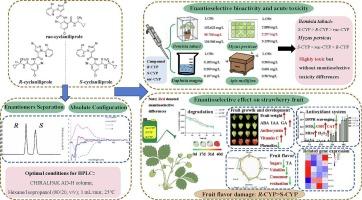Enantioselective evaluation of the chiral pesticide cyclaniliprole: Bioactivity, toxicity, and effects on strawberries flavor quality
IF 4
1区 农林科学
Q2 BIOCHEMISTRY & MOLECULAR BIOLOGY
引用次数: 0
Abstract
Chiral pesticide enantiomers often exhibit different bioactivities, ecotoxicity and environmental fate. In this study, the separation conditions were systematically optimized based on HPLC combined with chiral stationary phases. The novel chiral insecticide cyclaniliprole enantiomers were well separated using a CHIRALPAK AD-H column with hexane/isopropanol (80/20, v/v) as mobile phase at 1 mL/min flow rate and 25 °C column temperature. The absolute configuration of cyclaniliprole enantiomers was determined using density functional theory. Bioactivity and toxicity results showed S-CYP exhibited higher bioactivity against Myzus persica and Bemisia tabaci than R-CYP and racemate, while acute toxicity to Daphnia magna and Apis mellifera showed minimal enantioselectivity. The degradation half-life of R-CYP on strawberries (33.08d) was significantly higher than S-CYP (24.90d) and racemate (24.40d). Additionally, racemate and two enantiomers all promoted fruit growth and ripening by increasing GA, IAA, and ABA levels, with S-CYP showing more effective. However, fruit growth may come at the cost of sacrificing flavor. All three pesticide treatments triggered oxidative stress in strawberries, suppressed sugar-metabolism related genes expression, lowered soluble sugar content, and disrupted volatile synthesis, ultimately reducing fruit flavor. Moreover, cyclaniliprole and its enantiomers increased anthocyanins and vitamin C contents, but decreased total phenolic content. At the enantiomeric level, S-CYP suppressed volatiles more strongly but had less impact on sugars than R-CYP, and promoted nutrients more strongly. Therefore, from the perspective of strawberry fruit development and flavor quality, application of S-CYP was more superior. However, commercialization of the pure isomer requires further stereospecific data on its bioactivity, toxicity, and environmental behavior.

手性农药环虫腈的对映选择性评价:生物活性、毒性及对草莓风味品质的影响
手性农药对映体往往表现出不同的生物活性、生态毒性和环境命运。本研究采用手性固定相结合的高效液相色谱法对其分离条件进行了系统优化。采用CHIRALPAK AD-H色谱柱,以正己烷/异丙醇(80/20,v/v)为流动相,流速为1 mL/min,柱温为25℃,分离了新型手性杀虫剂环苯胺对映体。用密度泛函理论确定环苯环丙烯对映体的绝对构型。生物活性和毒性结果表明,S-CYP对桃蚜和烟粉虱的活性高于R-CYP和外消旋酸酯,而对大水蚤和蜜蜂的急性毒性表现出极小的对端选择性。R-CYP对草莓的降解半衰期(33.08d)显著高于S-CYP (24.90d)和外消旋体(24.40d)。外消旋体和两种对映体均通过提高GA、IAA和ABA水平促进果实生长和成熟,其中S-CYP效果更好。然而,水果生长可能是以牺牲味道为代价的。三种农药处理均引发草莓氧化应激,抑制糖代谢相关基因表达,降低可溶性糖含量,破坏挥发性合成,最终降低果实风味。此外,环苯环丙烯及其对映体提高了花青素和维生素C含量,但降低了总酚含量。在对映体水平上,S-CYP对挥发物的抑制作用强于R-CYP,但对糖的影响较小,对营养物质的促进作用强于R-CYP。因此,从草莓果实发育和风味品质的角度来看,S-CYP的应用更为优越。然而,纯异构体的商业化需要进一步的立体特异性数据,其生物活性,毒性和环境行为。
本文章由计算机程序翻译,如有差异,请以英文原文为准。
求助全文
约1分钟内获得全文
求助全文
来源期刊
CiteScore
7.00
自引率
8.50%
发文量
238
审稿时长
4.2 months
期刊介绍:
Pesticide Biochemistry and Physiology publishes original scientific articles pertaining to the mode of action of plant protection agents such as insecticides, fungicides, herbicides, and similar compounds, including nonlethal pest control agents, biosynthesis of pheromones, hormones, and plant resistance agents. Manuscripts may include a biochemical, physiological, or molecular study for an understanding of comparative toxicology or selective toxicity of both target and nontarget organisms. Particular interest will be given to studies on the molecular biology of pest control, toxicology, and pesticide resistance.
Research Areas Emphasized Include the Biochemistry and Physiology of:
• Comparative toxicity
• Mode of action
• Pathophysiology
• Plant growth regulators
• Resistance
• Other effects of pesticides on both parasites and hosts.

 求助内容:
求助内容: 应助结果提醒方式:
应助结果提醒方式:


